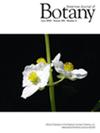Investigating historical drivers of latitudinal gradients in polyploid plant biogeography: A multiclade perspective
Abstract
Premise
The proportion of polyploid plants in a community increases with latitude, and different hypotheses have been proposed about which factors drive this pattern. Here, we aimed to understand the historical causes of the latitudinal polyploidy gradient using a combination of ancestral state reconstruction methods. Specifically, we assessed whether (1) polyploidization enables movement to higher latitudes (i.e., polyploidization precedes occurrences in higher latitudes) or (2) higher latitudes facilitate polyploidization (i.e., occurrence in higher latitudes precedes polyploidization).
Methods
We reconstructed the ploidy states and ancestral niches of 1032 angiosperm species at four paleoclimatic time slices ranging from 3.3 million years ago to the present, comprising taxa from four well-represented clades: Onagraceae, Primulaceae, Solanum (Solanaceae), and Pooideae (Poaceae). We used ancestral niche reconstruction models alongside a customized discrete character evolution model to allow reconstruction of states at specific time slices. Patterns of latitudinal movement were reconstructed and compared in relation to inferred ploidy shifts.
Results
No single hypothesis applied equally well across all analyzed clades. While significant differences in median latitudinal occurrence were detected in the largest clade, Poaceae, no significant differences were detected in latitudinal movement in any clade.
Conclusions
Our preliminary study is the first to attempt to connect ploidy changes to continuous latitudinal movement, but we cannot favor one hypothesis over another. Given that patterns seem to be clade-specific, more clades must be analyzed in future studies for generalities to be drawn.


 求助内容:
求助内容: 应助结果提醒方式:
应助结果提醒方式:


